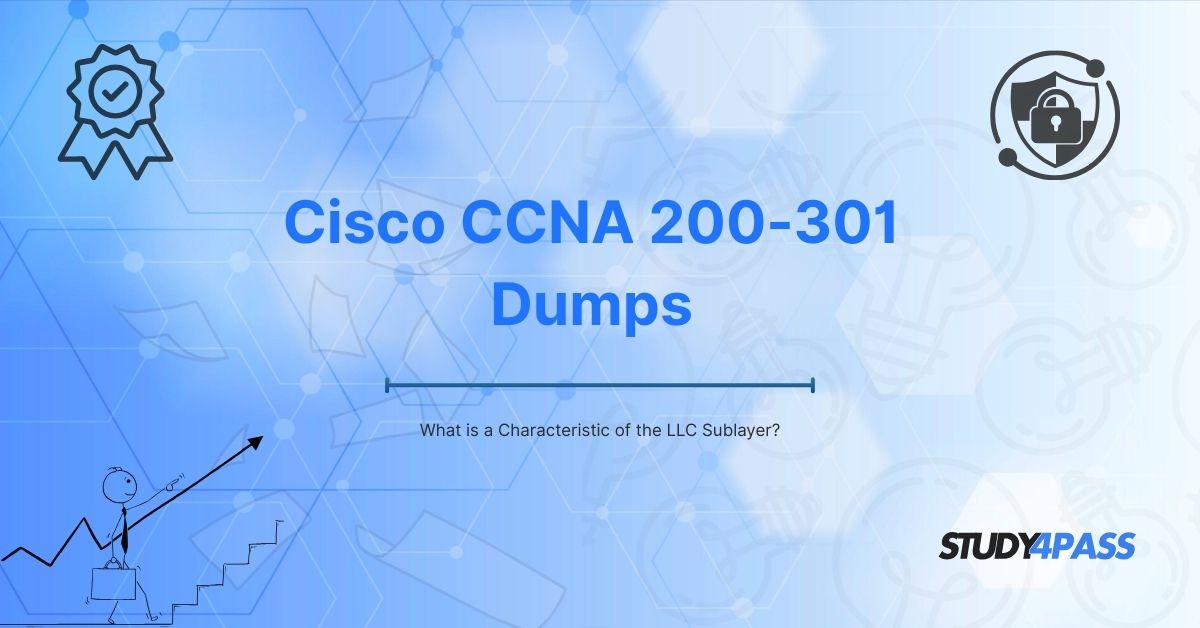Introduction to Cisco CCNA Ethernet Concepts Exam Prep Practice Tests
Preparing for the Cisco Certified Network Associate (CCNA) exam requires a strong understanding of Ethernet concepts, particularly the Logical Link Control (LLC) sublayer and its role in the OSI model. Many candidates rely on high-quality CCNA exam prep practice test, such as those from Study4Pass, to reinforce their knowledge and ensure exam success.
This article explores the LLC sublayer, its characteristics, functions, and real-world applications, while comparing it with the MAC sublayer. By the end, you'll have a solid grasp of these essential networking concepts, helping you ace your CCNA certification.
Position in the OSI Model
The Open Systems Interconnection (OSI) model is a seven-layer framework that standardizes network communication. The LLC sublayer resides in the Data Link Layer (Layer 2), working alongside the Media Access Control (MAC) sublayer.
- Layer 1 (Physical Layer): Deals with raw bit transmission over cables or wireless signals.
- Layer 2 (Data Link Layer): Divided into LLC and MAC sublayers, responsible for node-to-node communication, error detection, and framing.
The LLC sublayer acts as an intermediary between the Network Layer (Layer 3) and the MAC sublayer, ensuring smooth data flow.
Characteristics of the LLC Sublayer
The LLC sublayer has several defining characteristics:
- Protocol Multiplexing: Allows multiple network protocols (e.g., IPv4, IPv6, IPX) to operate over the same physical network.
- Flow Control: Manages data transmission rates to prevent overwhelming slower devices.
- Error Control: Detects and retransmits corrupted frames using acknowledgment mechanisms.
- Connection Services: Supports both connectionless (best-effort) and connection-oriented (reliable) communication.
These features make the LLC sublayer crucial for interoperability between different networking technologies.
Functions of the LLC Sublayer
The LLC sublayer performs several key functions:
1. Frame Synchronization
- Ensures the receiving device correctly identifies the start and end of a frame.
- Uses delimiters (flags) to mark frame boundaries.
2. Error Handling
- Implements Cyclic Redundancy Check (CRC) to detect transmission errors.
- Requests retransmission if errors are found.
3. Flow Regulation
- Prevents buffer overflow by controlling data transmission speed.
- Uses windowing techniques to manage data flow.
4. Multiplexing Network Protocols
- Enables different Layer 3 protocols (e.g., IP, ARP) to share the same physical network.
- Uses Service Access Points (SAPs) to identify upper-layer protocols.
Comparison with MAC Sublayer
While both the LLC and MAC sublayers operate in Layer 2, they serve different purposes:
| Feature | LLC Sublayer | MAC Sublayer |
| Primary Role | Manages logical connections and flow control | Handles physical addressing and access to media |
| Error Handling | Detects and corrects errors | Only detects errors (no correction) |
| Addressing | Uses SAPs for protocol identification | Uses MAC addresses for device identification |
| Standardization | Defined by IEEE 802.2 | Defined by IEEE 802.3 (Ethernet) |
The LLC sublayer ensures reliable communication, while the MAC sublayer focuses on efficient data transmission across the network.
Real-World Applications of the LLC Sublayer
Understanding the LLC sublayer is essential for configuring and troubleshooting networks. Here are some real-world applications:
1. Ethernet Networks
The LLC sublayer allows Ethernet to support multiple protocols (e.g., IP, IPX) over the same infrastructure.
2. Wireless Networks (Wi-Fi)
In IEEE 802.11 (Wi-Fi), the LLC sublayer ensures seamless integration with wired networks.
3. Virtual LANs (VLANs)
VLAN tagging (IEEE 802.1Q) relies on the LLC sublayer for proper frame identification.
4. Industrial Automation
PROFINET and EtherNet/IP use the LLC sublayer for deterministic communication in industrial networks.
Conclusion
Mastering the LLC sublayer is crucial for Cisco CCNA certification and real-world networking. Its role in error control, flow management, and protocol multiplexing makes it indispensable in modern networks.
By leveraging Study4Pass CCNA exam prep practice test, you can reinforce these concepts and confidently tackle exam questions on Ethernet, OSI layers, and Data Link protocols.
Special Discount: Offer Valid For Limited Time “Cisco 200-301 Exam Prep Practice Tests”
Sample Question for Cisco 200-301 Exam Prep Practice Tests
What is a Characteristic of the LLC Sublayer?
A) Manages MAC addressing for devices
B) Provides flow control and error checking
C) Operates at the Physical Layer
D) Encrypts data for secure transmission


